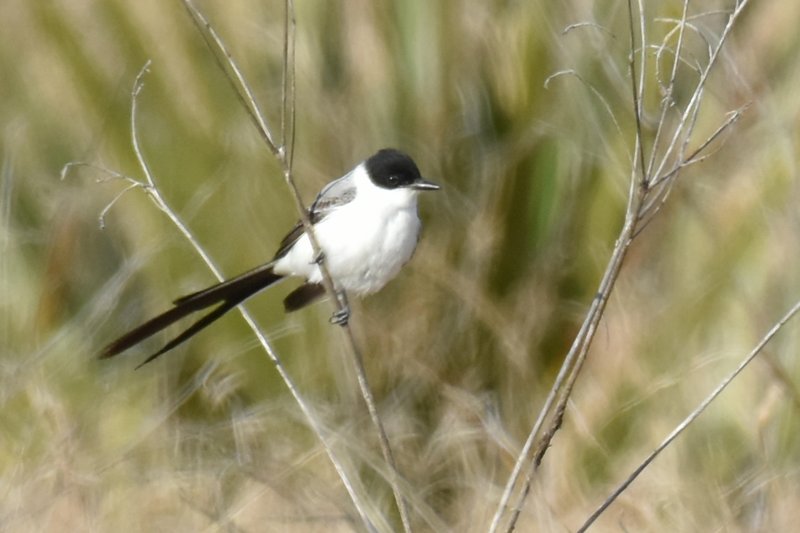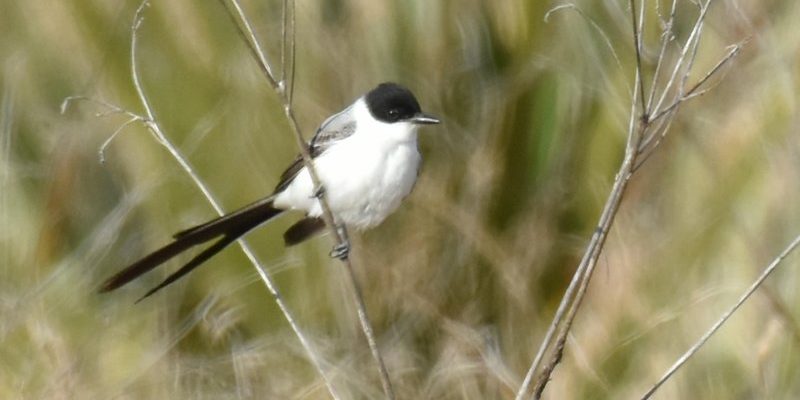
The Fork-Tailed Flycatcher is like the acrobat of the bird world. With its stunning tail that forked into two long points, you might mistake it for a streamer dancing through the sky. These birds are not just visually captivating; they are also highly skilled flyers, zipping around with impressive agility. If you’ve ever watched one of these lively creatures swoop and dive, you know that they bring a certain flair to any setting. Let’s dive into the world of the Fork-Tailed Flycatcher and discover what makes it so fascinating.
These birds belong to the tyrant flycatcher family, known for their sharp wit and lively antics. Found mostly in Central and South America, the Fork-Tailed Flycatcher is also a master of adaptability, thriving in various habitats. Imagine walking through a lush tropical rainforest or gliding along the edges of an open field – you might just spot one perched up high, surveying its domain with keen eyes. Their sassy attitude and distinct appearance make them a delightful subject of study for bird watchers and nature lovers alike.
Physical Characteristics
One of the most striking features of the Fork-Tailed Flycatcher is its remarkable tail. Measuring up to 10 inches long, those elongated feathers create a dramatic forked appearance that catches the eye. The body itself is sleek and slender, often adorned in a mix of black and white plumage, making it look somewhat like a tuxedo-clad performer ready to take the stage. Their heads are black, with a distinctive white throat that adds to their charm.
In terms of size, these birds typically reach lengths of about 7 to 8 inches, not including their impressive tail. This relatively small size allows them to maneuver quickly through the air as they hunt for insects or chase after other birds. You might see them swoop low over fields or dart around the edges of water bodies, always on the lookout for their next meal. It’s truly a sight to behold!
Interestingly, the gender of Fork-Tailed Flycatchers can be distinguished by their coloration. Females tend to have slightly duller plumage compared to their male counterparts. This difference is common in many bird species, where the males boast brighter colors to attract mates. They also have strong, pointed bills, ideal for catching flying insects, which is a primary part of their diet. When you think of them zipping through the air, it’s like they are equipped with specialized tools for their aerial life.
Habitat and Distribution
The Fork-Tailed Flycatcher primarily inhabits open landscapes, including savannas, grasslands, and the edges of forests. You can find them in regions from southern Mexico all the way down to Argentina. These birds enjoy open areas where they can easily spot their prey and have plenty of perching spots—like fences or power lines—where they can sit and scan the surroundings.
Another interesting aspect of their habitat is how adaptable they are. While they prefer open spaces, they can also thrive in urban areas as long as there are adequate food sources. This ability to adapt is crucial for survival in changing environments, especially with the increasing urbanization of their natural habitats. It’s like they’ve learned to turn challenges into opportunities, becoming a little less picky about where they set up shop.
During the breeding season, Fork-Tailed Flycatchers often build their nests in tree branches. They use materials like twigs, leaves, and sometimes even spider silk to create a cozy spot for their young ones. You might find these nests in trees near water sources, which offer both food and protection. Truly, they are the resourceful architects of the bird world!
Diet and Feeding Habits
What do Fork-Tailed Flycatchers eat? Well, their diet primarily consists of insects. They hunt down flies, beetles, and other small invertebrates that take to the air. Watching them in action is mesmerizing; they often snag insects mid-flight with incredible precision. It’s like they are performing an aerial ballet, showcasing their acrobatic skills and keen hunting prowess.
In addition to insects, they may also consume small fruits and berries, especially when insects are less abundant. This omnivorous diet helps them adapt to their environment and ensures that they have enough nourishment year-round. They have a knack for knowing what’s on the menu, adjusting their diet based on what’s available. This flexibility is vital for survival, particularly in regions where food sources might fluctuate.
When they aren’t hunting, you might find them perched on a branch, scanning the area for the slightest movement that indicates potential prey. They rely heavily on their keen eyesight to spot insects from a distance, launching themselves into the air to capture them. It’s a captivating dance of survival, showcasing how these birds are perfectly designed for their feeding habits.
Behavior and Social Structure
Fork-Tailed Flycatchers are known for their lively personalities. They are often seen in pairs or small groups, making them a delightful sight when you spot them flitting about together. Their social nature is apparent in their behaviors, as they often engage in playful flights and vocalizations, creating a symphony of chirps and whistles that fill the air.
During the breeding season, males are particularly vocal as they sing to attract females. Their songs are a mix of melodic whistles and sharp calls, which serve to establish territory as well. This vocal display, coupled with their striking appearance, certainly makes them quite the catch! When you hear their calls echoing through the trees, it’s like they are announcing their presence, making sure everyone knows they are around.
When it comes to defending their territories, Fork-Tailed Flycatchers can be quite assertive. They won’t hesitate to chase off intruders, especially during nesting season. This protective behavior showcases their commitment to family and survival, reminding us of the lengths they’ll go to ensure the safety of their young. Imagine them puffing up their chests, ready to defend their home with all their might!
Conservation Status
Currently, the Fork-Tailed Flycatcher is not considered threatened, thanks to its adaptability and wide distribution across suitable habitats. However, like many species, they face challenges due to habitat loss and environmental changes. Urbanization and agricultural expansion can lead to the loss of open spaces, making it important to monitor their populations closely.
Conservation efforts are crucial in maintaining healthy ecosystems for these birds and other wildlife in their habitats. Even small steps, like planting native vegetation and preserving natural areas, can make a significant difference in the lives of Fork-Tailed Flycatchers. It’s a reminder that each of us plays a role in protecting the delicate balance of nature around us.
Protecting their habitats means supporting biodiversity, which in turn helps stabilize our environment. The more species we preserve, the healthier our planet becomes. Every effort counts, whether it’s advocating for conservation policies or being mindful of our ecological footprint. By fostering awareness, we can help ensure that the Fork-Tailed Flycatcher continues to grace our skies for generations to come.
Interesting Facts
| Scientific Name: | Myiarchus furcatus |
| Length: | 7–8 inches (not including tail) |
| Wingspan: | Approximately 12–14 inches |
| Diet: | Insects and small fruits |
| Lifespan: | 4–6 years in the wild |
| Habitat: | Open fields, savannas, edges of forests |
| Breeding Season: | Typically from March to July |
FAQ
What does the Fork-Tailed Flycatcher look like?
The Fork-Tailed Flycatcher is easily recognizable due to its distinct forked tail, which is one of its most striking features. It has a sleek black body with a contrasting white throat and belly. This combination of colors makes it stand out, especially when flying. If you want to spot one, look for its graceful flight patterns and the long tail trailing behind it, making it appear almost like a kite in the air.
Where can I find Fork-Tailed Flycatchers?
You can find Fork-Tailed Flycatchers across Central and South America. They prefer open areas like fields, savannas, and edges of forests where they have plenty of perching spots. These adaptable birds often thrive in urban areas as well, so keep an eye out for them near parks or gardens. Their presence varies depending on the season, but they generally stay in regions that provide ample food and nesting options.
Are Fork-Tailed Flycatchers social birds?
Yes, Fork-Tailed Flycatchers are quite social! You’ll often see them in pairs or small flocks, especially outside of the breeding season. Their playful nature is evident in their interactions, as they engage in vocalizations and aerial displays. These social behaviors not only strengthen bonds between mates but also help in defending their territory from potential intruders.
How do Fork-Tailed Flycatchers reproduce?
During the breeding season, males attract females with vocal displays and flashy flights. Once they mate, females build nests in tree branches, often using twigs, leaves, and spider silk for construction. The female will lay a small clutch of eggs, usually around 2 to 4, which both parents help care for until they fledge. It’s a beautiful process that showcases their commitment to family and survival!
What do Fork-Tailed Flycatchers eat?
Fork-Tailed Flycatchers primarily feed on insects, making them adept at catching flies, beetles, and other small invertebrates on the wing. They might also eat some fruits when insects are less plentiful. Their feeding strategy involves hawking, where they watch for prey from a perch before swooping down to catch it in midair. This makes them not just skillful hunters but fascinating to watch!
Are Fork-Tailed Flycatchers endangered?
Luckily, Fork-Tailed Flycatchers are not considered endangered at this time. They have a wide distribution and a stable population. However, they are still affected by habitat loss and environmental changes. Conservation efforts are essential to maintain their habitats and ensure that these vibrant acrobats continue to thrive in the wild.
How long do Fork-Tailed Flycatchers live?
In the wild, Fork-Tailed Flycatchers typically live between 4 to 6 years. Factors such as environmental conditions, availability of food, and predation can influence their lifespan. In captivity, they might live longer with proper care, but their natural behaviors are best observed in the wild, where they can truly showcase their beauty and agility.
Can you keep a Fork-Tailed Flycatcher as a pet?
It is generally not advisable to keep Fork-Tailed Flycatchers or any wild birds as pets. They are best observed in their natural habitats, where they can express their natural behaviors and contribute to the ecosystem. Additionally, many species are protected by law, making it illegal to capture or keep them. Instead, consider creating a bird-friendly space in your yard to enjoy their presence!
How can I help protect Fork-Tailed Flycatchers?
You can help protect Fork-Tailed Flycatchers by supporting conservation efforts aimed at preserving their habitats. This can include advocating for natural spaces, planting native vegetation, and reducing pesticide use in your garden. Additionally, educating others about the importance of these birds and their ecosystems can raise awareness and promote action toward their conservation.
What is the significance of their tail?
The distinctive forked tail of the Fork-Tailed Flycatcher is not just for show; it plays a crucial role in its flight dynamics. This tail design helps with aerodynamics, allowing the bird to maneuver swiftly in the air as it chases down insects. The tail also serves as a visual display during courtship rituals, attracting mates and establishing dominance in territorial disputes. It’s both an adaptation and a symbol of their agility!

